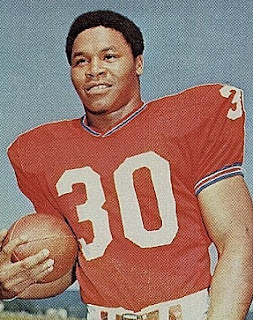The Florida Blazers and Houston Texans were off to very different starts in the World Football League’s inaugural season as they met in Houston on July 31, 1974.
The Blazers were undefeated at 3-0. Coached by Jack Pardee,
a recently retired star linebacker with the Rams and Redskins, the Blazers
featured a veteran NFL backup, Bob Davis, at quarterback. While there was more veteran
talent at running back in A.D. Whitfield and Jim Strong, rookie Tommy Reamon
had emerged as the leader of the group. The defense was especially able in the
backfield, featuring more experienced players in safeties Rickie Harris and
W.K. Hicks along with CB Miller Farr.
Houston, on the other hand, was 1-2 and had yet to score
an offensive touchdown (the defense had accounted for one in the club’s lone
victory). Head Coach Jim Garrett’s team had plenty of experience, which was
apparent on defense, but not much scoring punch. QB Mike Taliaferro had already
missed time due to injury while the running game was led by FB Jim Nance (pictured above), who
twice led the American Football League in rushing. The clubs had met the
previous week in Orlando and Florida won handily by a 15-3 score.
16,268 fans showed up for the Wednesday night contest
billed as “Nickel Hot Dog Night” at the Astrodome. Less than two minutes into
the first quarter, Houston safety John Mallory intercepted a Bob Davis pass and
returned it 59 yards to the Florida one yard line. From there, Jim Nance plunged
to the left for a touchdown on the next play. While the try for the action point
failed, the Texans held the early 7-0 lead (in the WFL, touchdowns counted for
seven points and were followed by an action point, which could not be kicked).
Later in the opening period, the Blazers got on the board
following a 42-yard drive with a Les Perry field goal from 26 yards. Along the
way, Davis threw to RB Jim Strong for an 18-yard gain that proved to be the
longest of the game for either club. Perry connected on another field goal in
the second quarter, this time from 21 yards, to climax a 36-yard advance that
was helped along by a 17-yard defensive pass interference penalty.
Houston’s Mike Taliaferro left the game due to injury and
was relieved by Dave Mays, a rookie out of Texas Southern. It seemed to ignite
the Texans, who reached the Florida eight before Charlie Durkee’s 24-yard field
goal attempt sailed wide of the mark.
Beyond that, Houston’s defensive line of ends Don Brumm
and Joe Robb and tackles Al Dotson and Jim Kanicki kept constant pressure on
Bob Davis and the home team held on to the narrow one-point lead for the
remainder of the game. The Texans were threatening late in the fourth quarter,
but after reaching the Florida three they came up empty when time ran out.
Still, they won by a narrow 7-6 verdict.
In the defense-dominated game, the Texans led in total
yards (157 to 122) and first downs (14 to 9), with the offense almost perfectly
balanced between rushing yardage (79) and passing (78). Houston also turned the
ball over three times, to two by the Blazers. However, the Texans recorded six
sacks and Florida was penalized 16 times, at a cost of 136 yards, to 7 flags
for 81 yards thrown on Houston.
Mike Taliaferro completed one of three passes for 11
yards before exiting the game and Dave Mays was 7 of 17 for 67 yards while
giving up an interception. Jim Nance gained just 29 yards on 10 carries, but
that included the game’s only touchdown. WR Rick Eber led Houston’s receivers
with 5 catches for 46 yards.
For the Blazers, Bob Davis was successful on only 5 of 18
throws for 54 yards and was picked off twice. Tommy Reamon was the leading
ground gainer with a lackluster 21 yards on 15 attempts and Jim Strong, who ran
for 14 yards on 10 carries, led the club in pass receiving with three catches
for 27 yards.
Houston tied Portland the following week before dropping
five of their next six games. At that point, the underfinanced franchise moved
to Shreveport, Louisiana and was renamed the Steamer, finishing up with a
record of 7-12-1 that tied with Portland at the bottom of the WFL’s Western Division.
Florida won its next three games on the way to topping the Eastern Division at
14-6. However, the club was also beset by financial problems that included
missed payrolls, although the Blazers still made it to the WFL Championship
Game (the World Bowl) and lost narrowly to the Birmingham Americans.
Jim Nance’s touchdown against the Blazers was his first
of eight over the course of the season. The 31-year-old veteran rushed for 1240
yards on an even 300 carries. John Mallory’s interception that set up the TD
was one of five on the year, and at 59 yards was his longest return.












